Development of a 7-DOF Biodynamic Model for a Seated Human and a Hybrid Optimization Method for Estimating Human-Seat Interaction Parameters
Abstract
:1. Introduction
2. Development of the 7-DOF Human Model
2.1. Model Description
2.2. Derivation of Model Equations of Motion
2.3. Linearization of Equations of Motion
3. Human Vibration Experiment and Identification of Human Parameters
3.1. Experimental Set-Up and Procedures
3.2. Identification of Human Parameters
4. Optimization Methods
4.1. Objective Function Formulation
4.2. Gradient-Based Algorithm (GBA)
4.3. Genetic Algorithm (GA)
4.4. Hybrid Optimization Method (HOM)
5. Results
5.1. Experimental Results
5.2. Model Fitting Results Obtained by the Optimization Methods
5.3. Estimated Parameters and Parameter Sensitivity
6. Discussions
6.1. Proposed Model
6.2. Estimation of Unknown Parameters Using Proposed HOM
7. Conclusions
Author Contributions
Funding
Institutional Review Board Statement
Informed Consent Statement
Data Availability Statement
Conflicts of Interest
Appendix A. Deflection Terms and Non-linear Equations of Motion of the 7-DOF Human Body Model
Appendix B. Definition of Elements of the Mass, Damping, and Stiffness Matrices and the Force Vector
References
- Bovenzi, M.; Betta, A. Low-back disorders in agricultural tractor drivers exposed to whole-body vibration and postural stress. Appl. Ergon. 1994, 25, 231–241. [Google Scholar] [CrossRef] [PubMed]
- Bovenzi, M.; Hulshof, C.T.J. An Updated Review of Epidemiologic Studies on the Relationship Between Exposure to Whole-Body Vibration and Low Back Pain (1986–1997). Int. Arch. Occup. Environ. Health 1999, 72, 351–365. [Google Scholar] [CrossRef] [PubMed]
- International Organization for Standardization (ISO). Mechanical Vibration and Shock: Range of Idealized Values to Characterize Seated-Body Biodynamic Response under Vertical Vibration; International Organization for Standardization: Geneva, Switzerland, 2002. [Google Scholar]
- Zhou, Z.; Griffin, M.J. Response of the Seated Human Body to Whole-Body Vertical Vibration: Discomfort Caused by Sinusoidal Vibration. Ergonomics 2014, 57, 714–732. [Google Scholar] [CrossRef]
- Kim, E.; Fard, M.; Kato, K. Characterisation of the Human-seat Coupling in Response to Vibration. Ergonomics 2017, 60, 1085–1100. [Google Scholar] [CrossRef] [PubMed]
- Rakheja, S.; Dewangan, K.N.; Dong, R.G.; Marcotte, P.; Pranesh, A. Whole-Body Vibration Biodynamics—A Critical Review: II. Biodynamic Modelling. Int. J. Veh. Perform. 2020, 6, 52–84. [Google Scholar] [CrossRef]
- Matsumoto, Y.; Griffin, M.J. Non-linear Characteristics in the Dynamic Responses of Seated Subjects Exposed to Vertical Whole-Body Vibration. J. Biomech. Eng. 2002, 124, 527–532. [Google Scholar] [CrossRef]
- Cho, Y.; Yoon, Y.S. Biomechanical Model of Human on Seat With Backrest for Evaluating Ride Quality. Int. J. Ind. Ergon. 2001, 27, 331–345. [Google Scholar] [CrossRef]
- Kim, T.H.; Kim, Y.T.; Yoon, Y.S. Development of a biomechanical model of the human body in a sitting posture with vibration transmissibility in the vertical direction. Int. J. Ind. Ergon. 2005, 35, 817–829. [Google Scholar] [CrossRef]
- Bae, J.J.; Kang, N. Development of a Five-Degree-of-Freedom Seated Human Model and Parametric Studies for its Vibrational Characteristics. Shock Vib. 2018, 2018, 1649180. [Google Scholar] [CrossRef]
- Tufano, S.; Griffin, M.J. Nonlinearity in the vertical transmissibility of seating: The role of the human body apparent mass and seat dynamic stiffness. Veh. Syst. Dyn. 2013, 51, 122–138. [Google Scholar] [CrossRef]
- Dewangan, K.N.; Rakheja, S.; Marcotte, P.; Shahmir, A. Effects of elastic seats on seated body apparent mass responses to vertical whole-body vibration. Ergonomics 2015, 58, 1175–1190. [Google Scholar] [CrossRef] [PubMed]
- Wang, W.; Rakheja, S.; Boileau, P.É. Effect of back support condition on seat to head transmissibilities of seated occupants under vertical vibration. J. Low Freq. Noise Vib. Act. Control 2006, 25, 239–259. [Google Scholar] [CrossRef]
- Matsumoto, Y.; Griffin, M.J. Modelling the dynamic mechanisms associated with the principal resonance of the seated human body. Clin. Biomech. 2001, 16, S31–S44. [Google Scholar] [CrossRef] [PubMed]
- Shao, X.; Xu, N.; Liu, X. Investigation and Application on the Vertical Vibration Models of the Seated Human Body. Automot. Innov. 2018, 1, 263–271. [Google Scholar] [CrossRef]
- Huang, Y.; Zhang, P.; Liang, S. Apparent mass of the seated human body during vertical vibration in the frequency range 2–100 Hz. Ergonomics 2020, 63, 1150–1163. [Google Scholar] [CrossRef]
- Zhang, S.; Shi, W.; Chen, Z. Modeling and Parameter Identification of Seated Human Body with the Reference Vector Guided Evolutionary Algorithm. Adv. Mech. Eng. 2021, 13, 16878140211062679. [Google Scholar] [CrossRef]
- Zhao, Y.; Alashmori, M.; Bi, F.; Wang, X. Parameter Identification and Robust Vibration Control of a Truck Driver’s Seat System Using Multi-Objective Optimization and Genetic Algorithm. Appl. Acoust. 2021, 173, 107697. [Google Scholar] [CrossRef]
- Yazdi, S.J.M.; Cho, K.S.; Kang, N. Characterization of the Viscoelastic Model of In Vivo Human Posterior Thigh Skin using Ramp-Relaxation Indentation Test. Korea-Aust. Rheol. J. 2018, 30, 293–307. [Google Scholar] [CrossRef]
- Zhang, X.; Yu, P.; Li, Y.; Qiu, Y.; Sun, C.; Wang, Z.; Liu, C. Dynamic Interaction Between the Human Body and the Seat During Vertical Vibration: Effect of Inclination of the Seat Pan and the Backrest on Seat Transmissibilities. Ergonomics 2022, 65, 691–703. [Google Scholar] [CrossRef]
- Xiu, W.; Zhang, L.; Ma, O. Experimental study of a momentum-based method for identifying the inertia barycentric parameters of a human body. Multibody Syst. Dyn. 2016, 36, 237–255. [Google Scholar] [CrossRef]
- Size Korea. The 8th Korean Human Dimensions Survey Project. Available online: https://sizekorea.kr/human-info/meas-report?measDegree=8 (accessed on 15 March 2021).
- Ma, Y.; Kwon, J.; Mao, Z.; Lee, K.; Li, L.; Chung, H. Segment Inertial Parameters of Korean Adults Estimated from Three-Dimensional Body Laser Scan Data. Int. J. Ind. Ergon. 2011, 41, 19–29. [Google Scholar] [CrossRef]
- Kim, K.S.; Kim, J.; Kim, K.J. Dynamic Modeling of Seated Human Body Based on Measurements of Apparent Inertia Matrix for Fore-and-Aft/Vertical/Pitch Motion. J. Sound Vib. 2011, 330, 5716–5735. [Google Scholar] [CrossRef]
- Liang, C.C.; Chiang, C.F. Modeling of a Seated Human Body Exposed to Vertical Vibrations in Various Automotive Postures. Ind. Health 2008, 46, 125–137. [Google Scholar] [CrossRef] [PubMed]
- Qiu, Y.; Griffin, M.J. Modelling the fore-and-aft apparent mass of the human body and the transmissibility of seat backrests. Veh. Syst. Dyn. 2011, 49, 703–722. [Google Scholar] [CrossRef]
- Wu, J.; Qiu, Y.; Sun, C. Modelling and analysis of coupled vibration of human body in the sagittal and coronal planes exposed to vertical, lateral and roll vibrations and the comparison with modal test. Mech. Syst. Signal Proc. 2022, 166, 108439. [Google Scholar] [CrossRef]
- Math Works, Inc. Genetic Algorithm and Direct Search Toolbox for Use with MATLAB: User’s Guide. Available online: http://cda.psych.uiuc.edu/matlab_pdf/gads_tb.pdf (accessed on 2 May 2023).
- Fairley, T.E.; Griffin, M.J. The apparent mass of the seated human body: Vertical vibration. J. Biomech. 1989, 22, 81–94. [Google Scholar] [CrossRef]
- Nawayseh, N.; Griffin, M.J. Non-linear dual-axis biodynamic response to vertical whole-body vibration. J. Sound Vibr. 2003, 268, 503–523. [Google Scholar] [CrossRef]
- Wu, J.; Qiu, Y. Modelling of Seated Human Body Exposed to Combined Vertical, Lateral and Roll Vibrations. J. Sound Vibr. 2020, 485, 115509. [Google Scholar] [CrossRef]
- Wong, J.Y. Terramechanics and Off-Road Vehicle Engineering: Terrain Behaviour, Off-Road Vehicle Performance and Design; Butterworth-Heinemann: Oxford, UK, 2009. [Google Scholar]
- Mansfield, N.J.; Griffin, M.J. Non-linearities in apparent mass and transmissibility during exposure to whole-body vertical vibration. J. Biomech. 2000, 33, 933–941. [Google Scholar] [CrossRef]
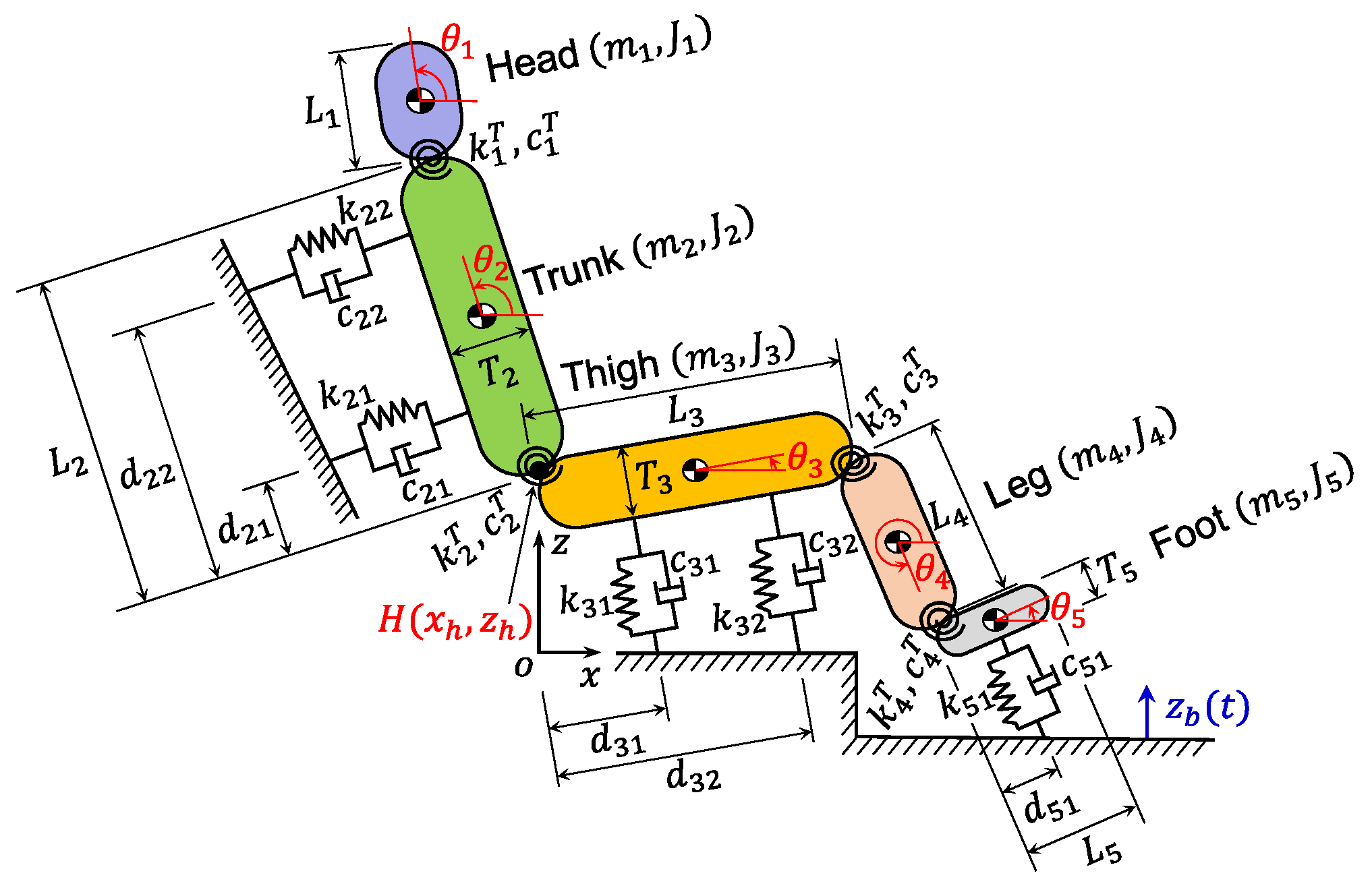
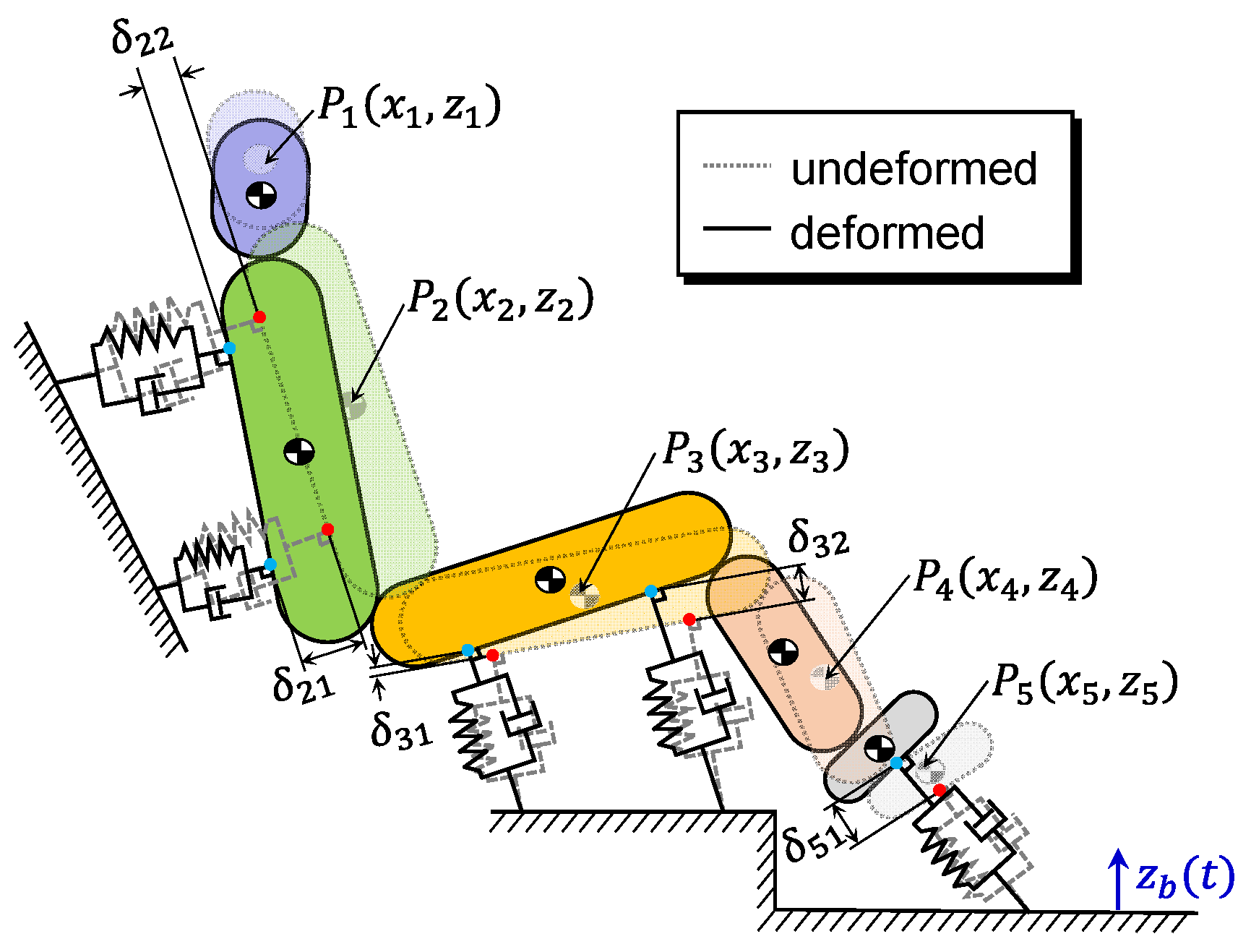


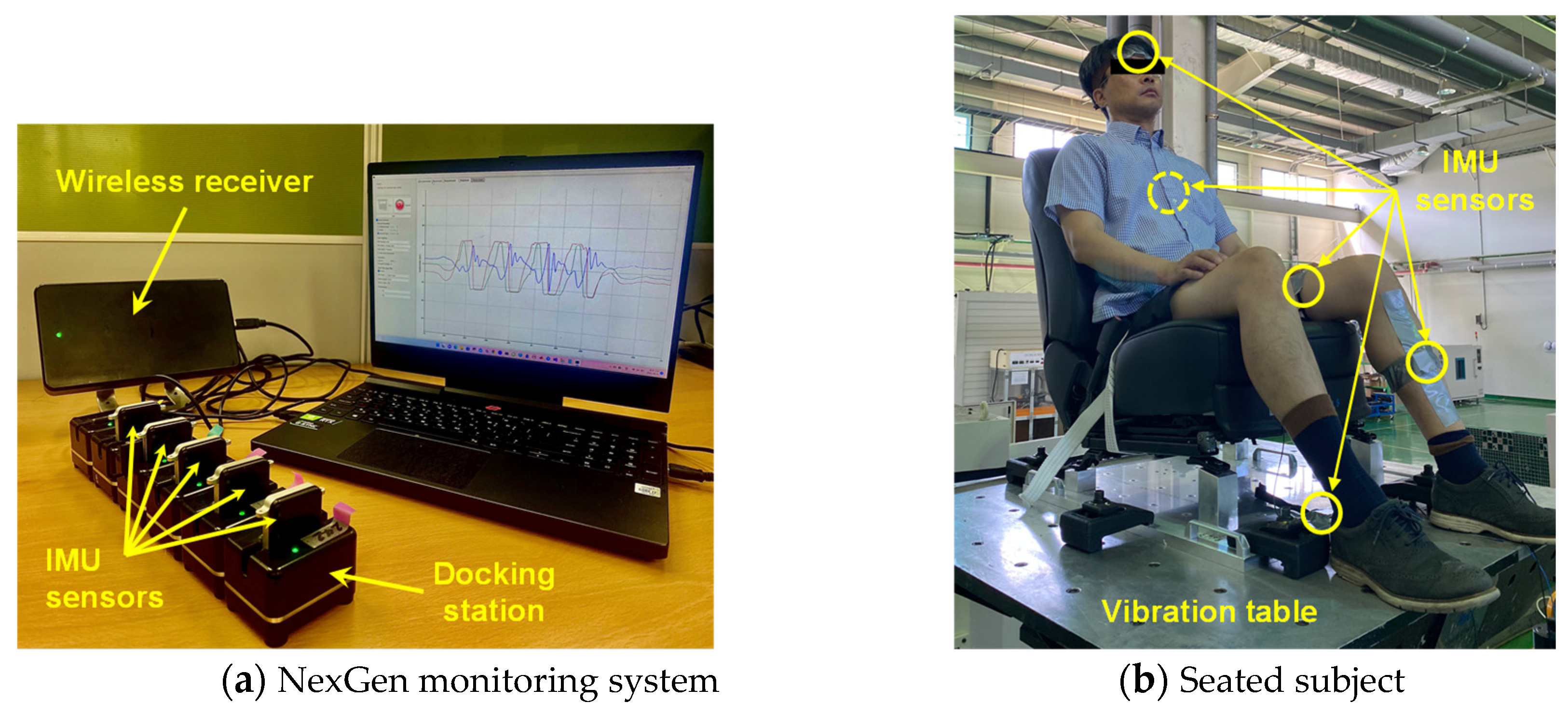
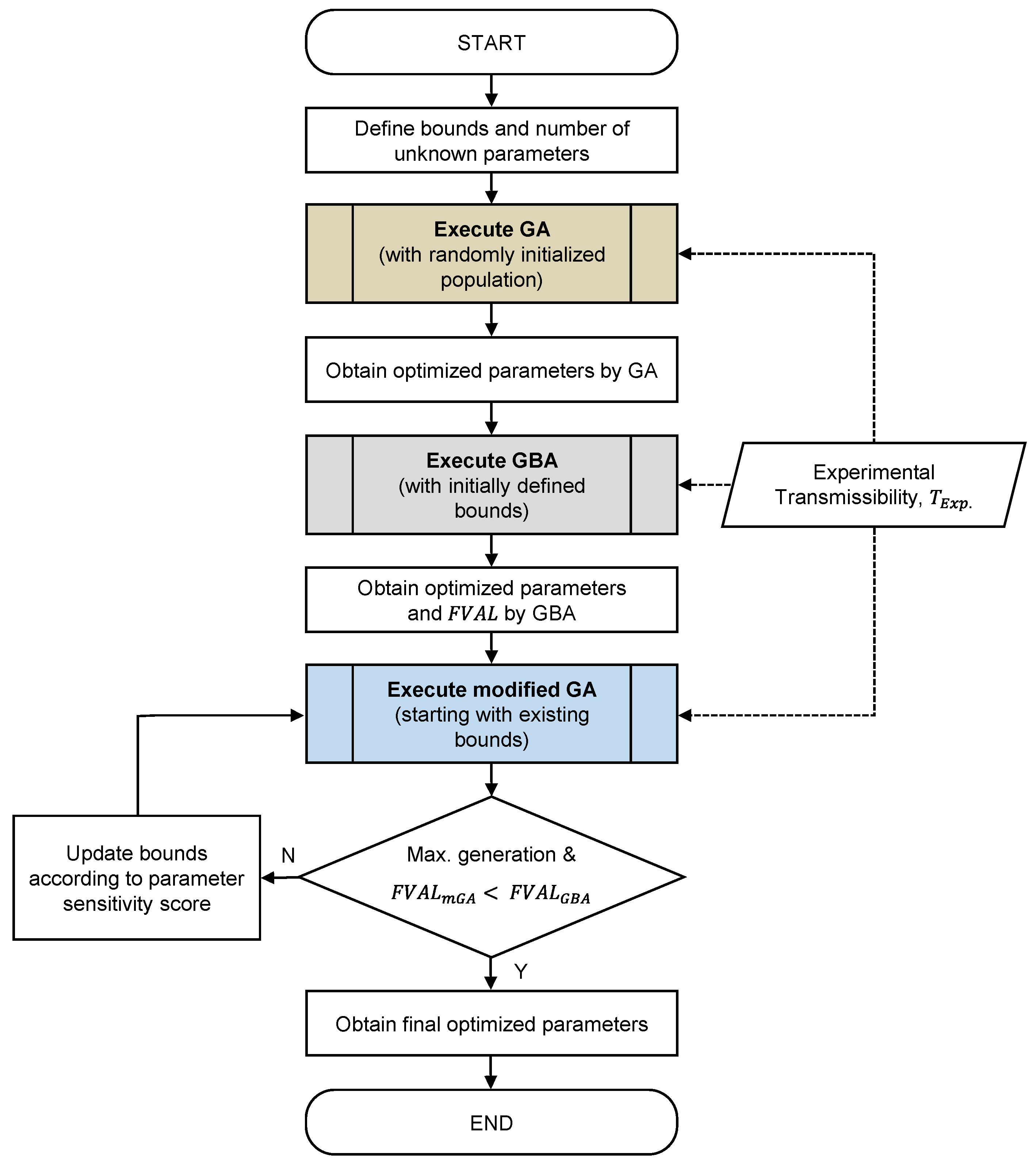

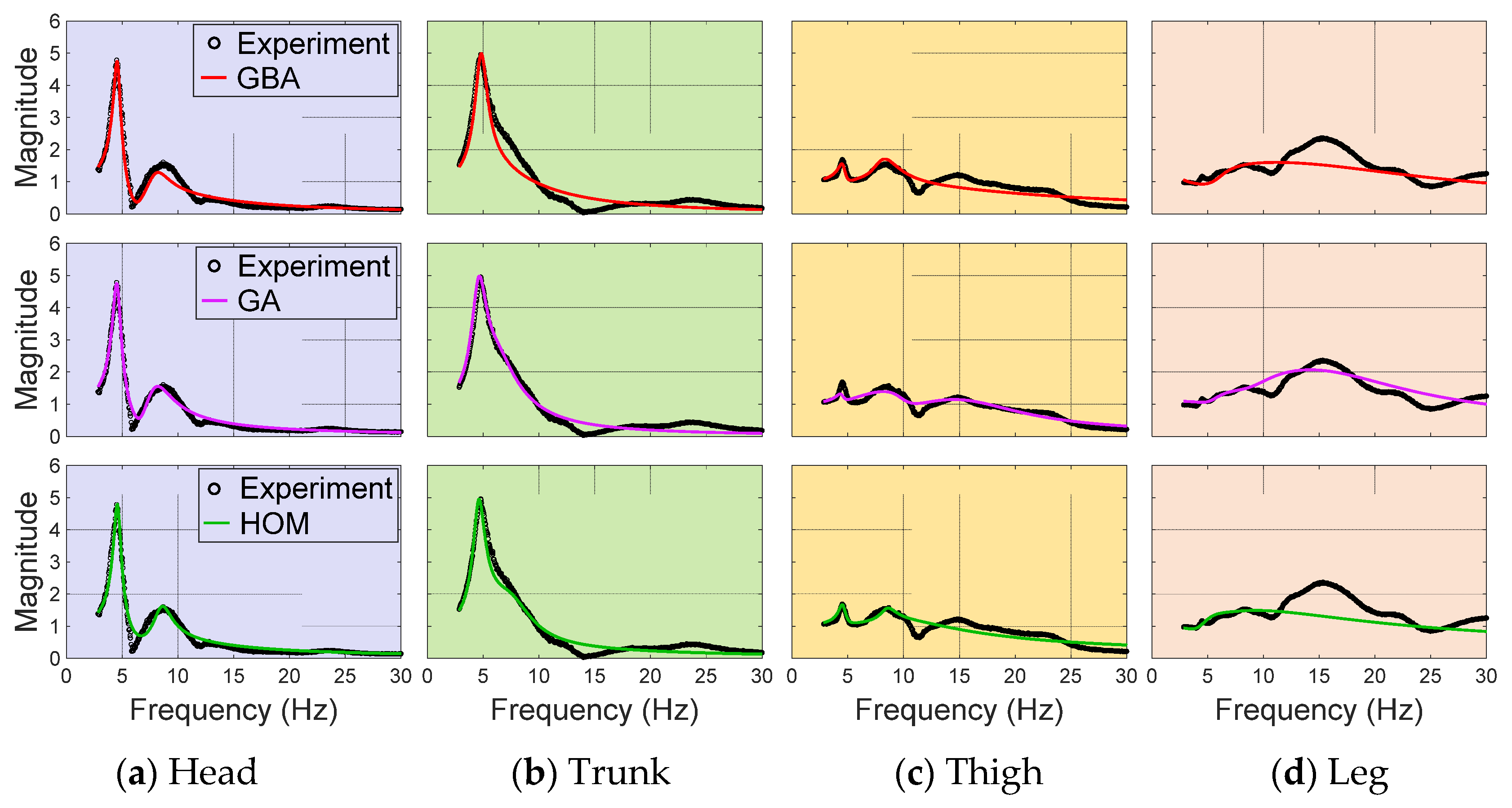
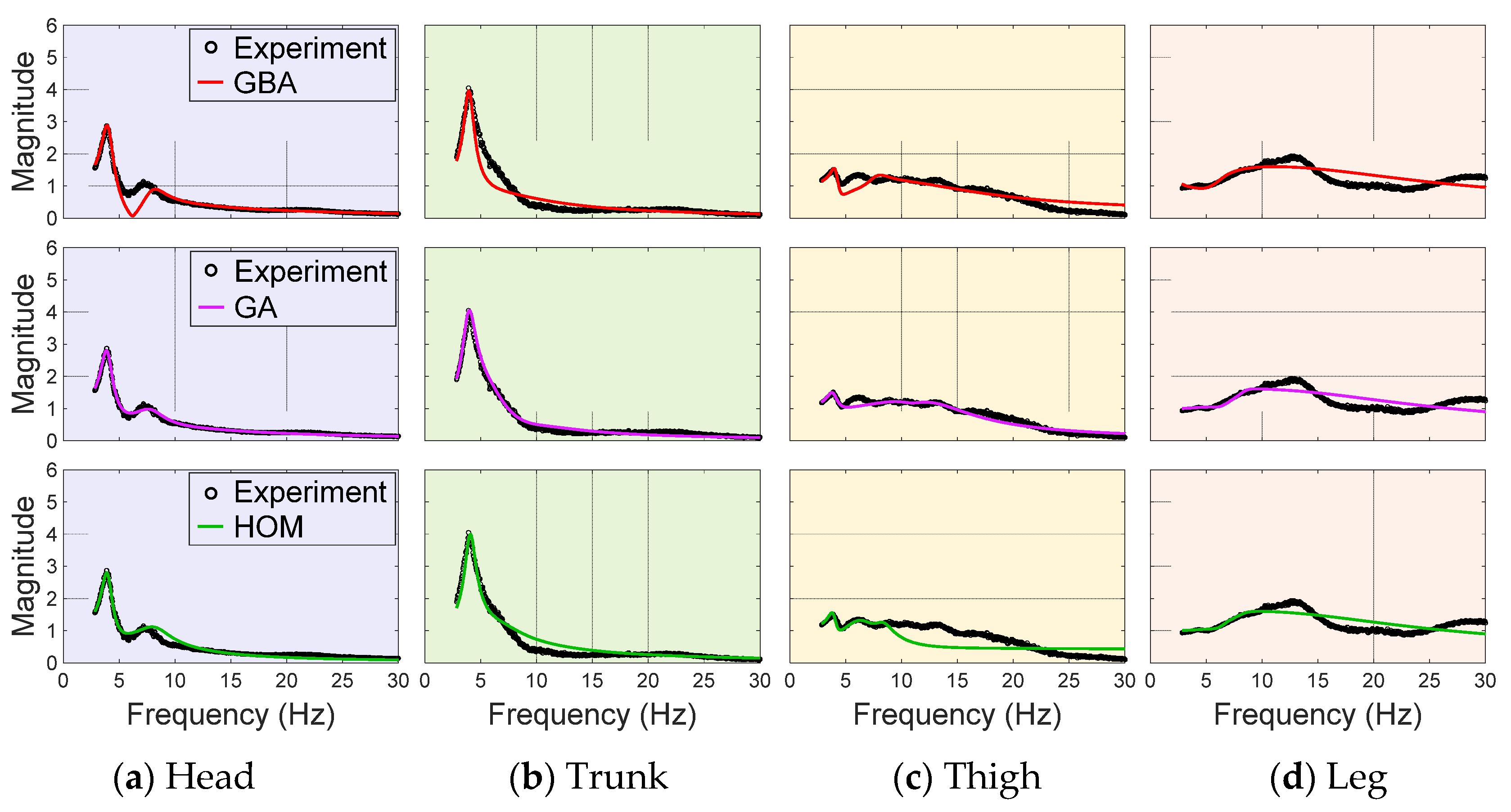
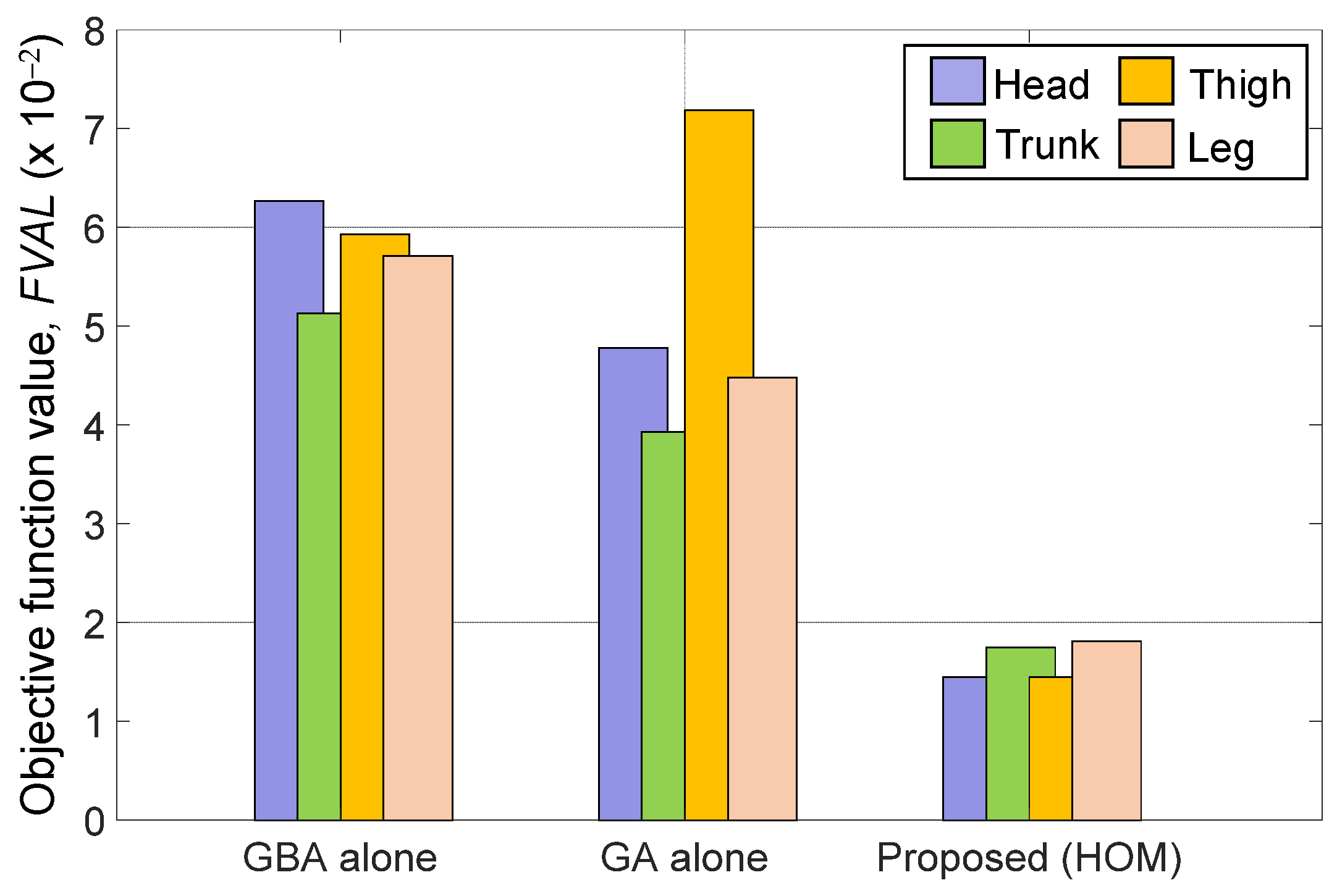
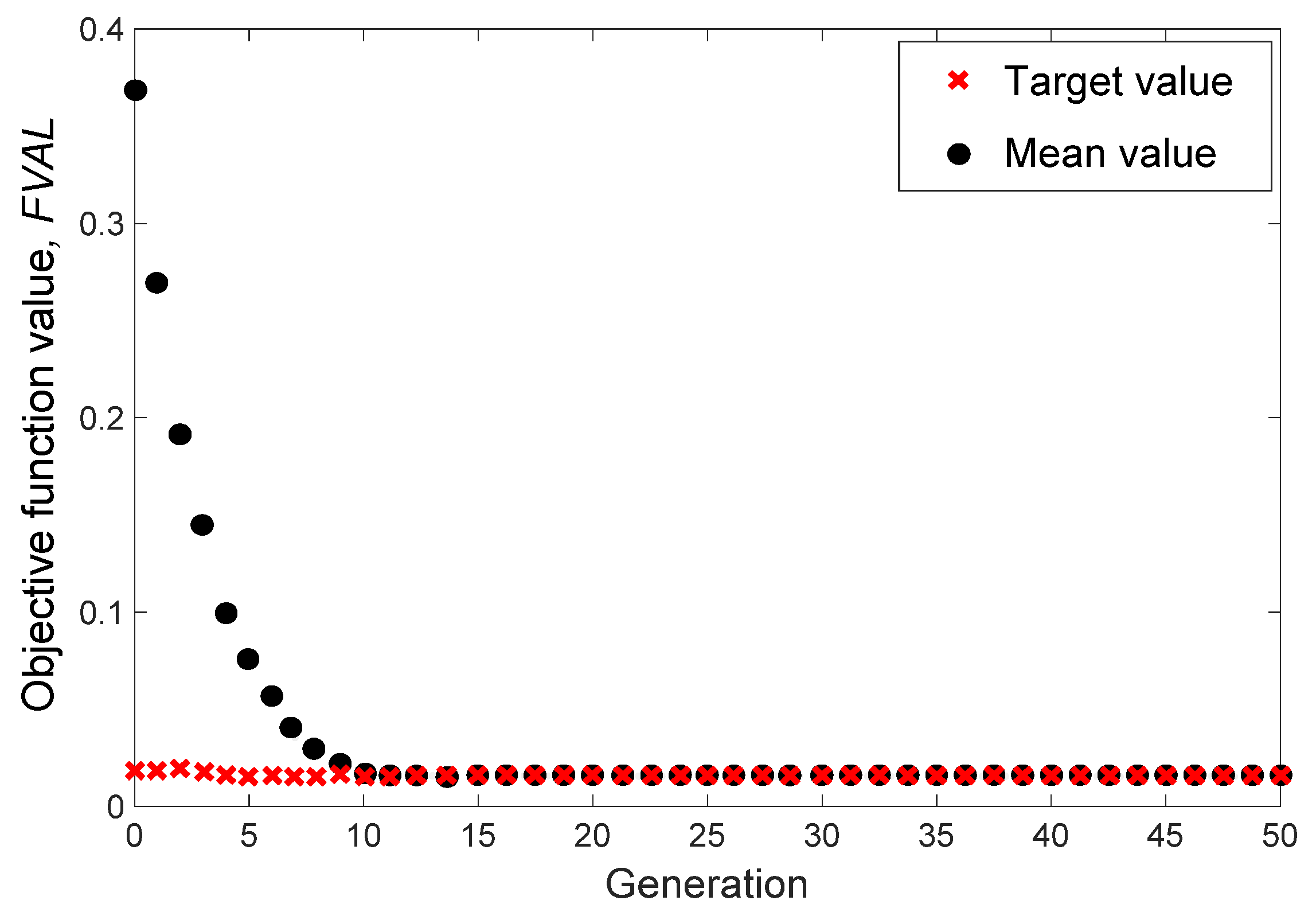
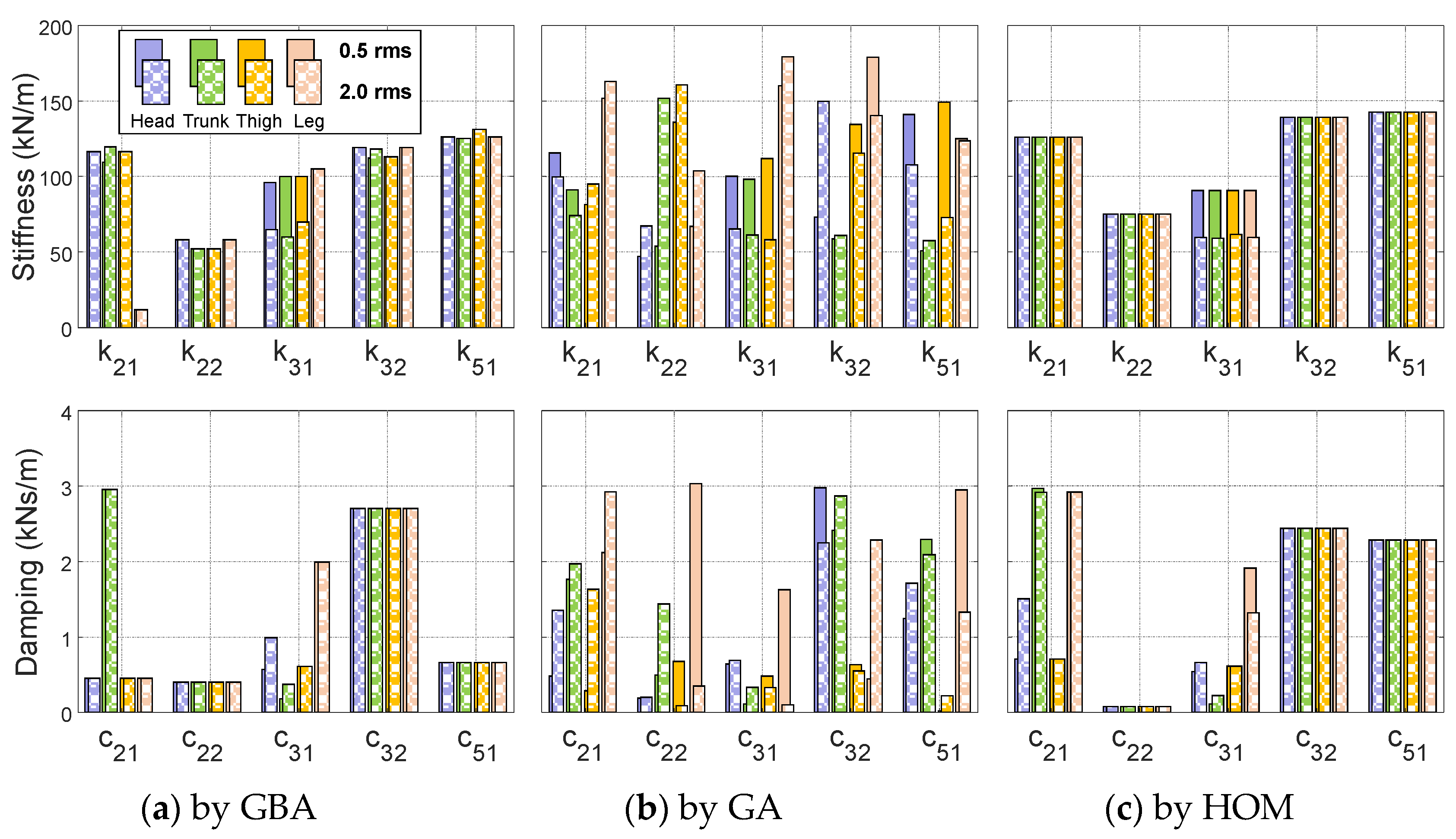

| Model | Max. Dynamic Force | Max. Displacement | Operating Frequency | Vibration Table |
|---|---|---|---|---|
| MTS 248.05 Hydraulic | ±50 kN | 75 mm | 0.1~100 Hz | 1.2 × 1.2 m |
| Mass (kg) | Moment of Inertia (kg·m2) | Length (m) | Thickness (m) | Initial Angle (deg.) | Spring Ends Distance (m) | ||||||
|---|---|---|---|---|---|---|---|---|---|---|---|
| 5.66 | 0.037 | 0.263 | 100 | 0.100 | |||||||
| 37.96 | 2.050 | 0.599 | 0.224 | 111 | 0.479 | ||||||
| 18.74 | 0.324 | 0.495 | 0.156 | 12 | 0.088 | ||||||
| 6.08 | 0.061 | 0.368 | 306 | 0.459 | |||||||
| 1.56 | 0.005 | 0.248 | 0.076 | 10 | 0.124 | ||||||
| Method | Head (%) | Trunk (%) | Thigh (%) | Leg (%) | Average (%) |
|---|---|---|---|---|---|
| GBA | 95.8 | 92.5 | 94.6 | 82.8 | 91.4 |
| GA | 98.4 | 97.3 | 90.9 | 83.9 | 92.6 |
| HOM | 99.0 | 98.9 | 97.9 | 91.4 | 96.8 |
| Method | Head (%) | Trunk (%) | Thigh (%) | Leg (%) | Average (%) |
|---|---|---|---|---|---|
| GBA | 90.5 | 91.4 | 90.7 | 92.9 | 91.4 |
| GA | 99.9 | 99.5 | 93.4 | 94.2 | 96.7 |
| HOM | 99.5 | 98.9 | 98.7 | 95.9 | 98.2 |
| Method | Objective Function Value, FVAL | |||
|---|---|---|---|---|
| Head | Trunk | Thigh | Leg | |
| GBA alone | 0.0478 | 0.0393 | 0.0719 | 0.0448 |
| GA alone | 0.0627 | 0.0513 | 0.0593 | 0.0571 |
| HOM Steps | Objective Function Value, FVAL | |||
|---|---|---|---|---|
| Head | Trunk | Thigh | Leg | |
| GA step | 0.0328 | 0.0333 | 0.0394 | 0.0348 |
| GBA step | 0.0227 | 0.0293 | 0.0263 | 0.0301 |
| MGA step | 0.0145 | 0.0175 | 0.0145 | 0.0181 |
| Method | Computation Time (S) | |||
|---|---|---|---|---|
| Head | Trunk | Thigh | Leg | |
| GBA alone | 1510 | 1620 | 1610 | 1760 |
| GA alone | 1310 | 1290 | 1310 | 1390 |
| HOM Steps | Computation Time (S) | |||
|---|---|---|---|---|
| Head | Trunk | Thigh | Leg | |
| GA step | 1066 | 1092 | 1066 | 1100 |
| GBA step | 210 | 200 | 206 | 260 |
| MGA step | 250 | 240 | 210 | 290 |
| Total | 1526 | 1532 | 1482 | 1650 |
| Examined Responses | Decreasing Order of Sensitivity |
|---|---|
| First resonance frequency | |
| Second resonance frequency | |
| Peak magnitude of resonance frequency |
Disclaimer/Publisher’s Note: The statements, opinions and data contained in all publications are solely those of the individual author(s) and contributor(s) and not of MDPI and/or the editor(s). MDPI and/or the editor(s) disclaim responsibility for any injury to people or property resulting from any ideas, methods, instructions or products referred to in the content. |
© 2023 by the authors. Licensee MDPI, Basel, Switzerland. This article is an open access article distributed under the terms and conditions of the Creative Commons Attribution (CC BY) license (https://creativecommons.org/licenses/by/4.0/).
Share and Cite
Alabi, A.O.; Song, B.-G.; Bae, J.-J.; Kang, N. Development of a 7-DOF Biodynamic Model for a Seated Human and a Hybrid Optimization Method for Estimating Human-Seat Interaction Parameters. Appl. Sci. 2023, 13, 10065. https://doi.org/10.3390/app131810065
Alabi AO, Song B-G, Bae J-J, Kang N. Development of a 7-DOF Biodynamic Model for a Seated Human and a Hybrid Optimization Method for Estimating Human-Seat Interaction Parameters. Applied Sciences. 2023; 13(18):10065. https://doi.org/10.3390/app131810065
Chicago/Turabian StyleAlabi, Abeeb Opeyemi, Byoung-Gyu Song, Jong-Jin Bae, and Namcheol Kang. 2023. "Development of a 7-DOF Biodynamic Model for a Seated Human and a Hybrid Optimization Method for Estimating Human-Seat Interaction Parameters" Applied Sciences 13, no. 18: 10065. https://doi.org/10.3390/app131810065
APA StyleAlabi, A. O., Song, B.-G., Bae, J.-J., & Kang, N. (2023). Development of a 7-DOF Biodynamic Model for a Seated Human and a Hybrid Optimization Method for Estimating Human-Seat Interaction Parameters. Applied Sciences, 13(18), 10065. https://doi.org/10.3390/app131810065





